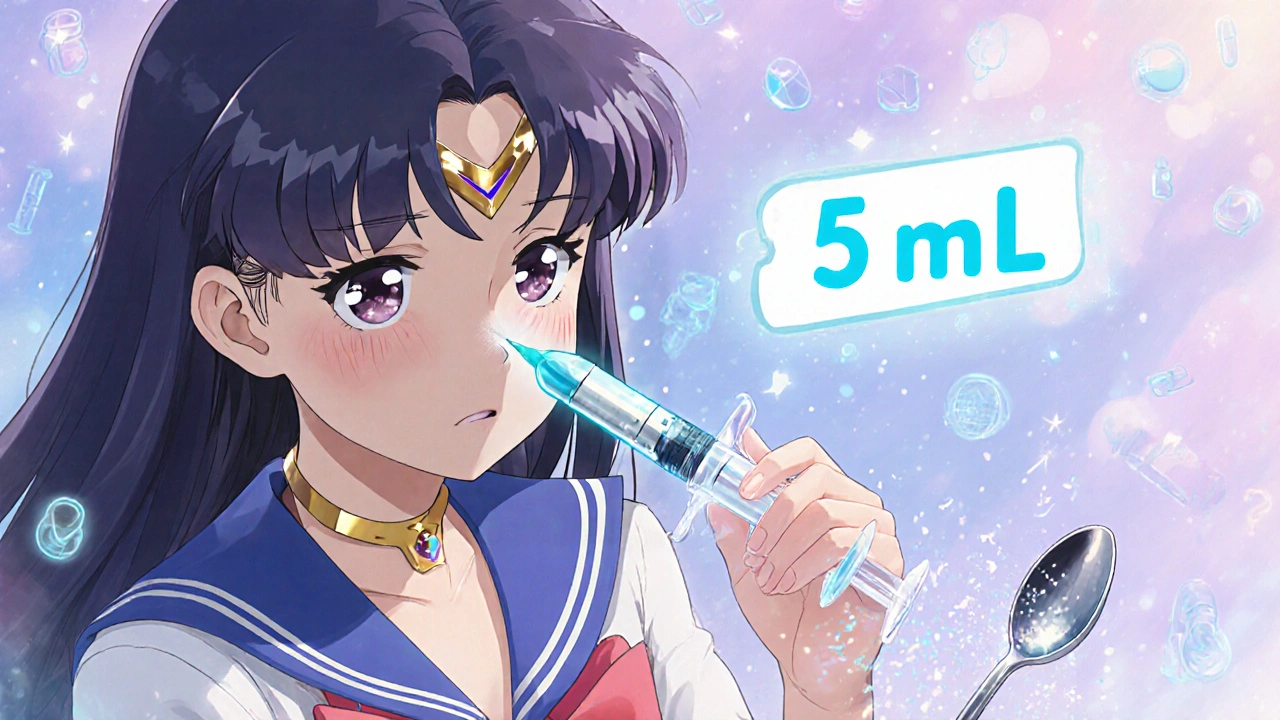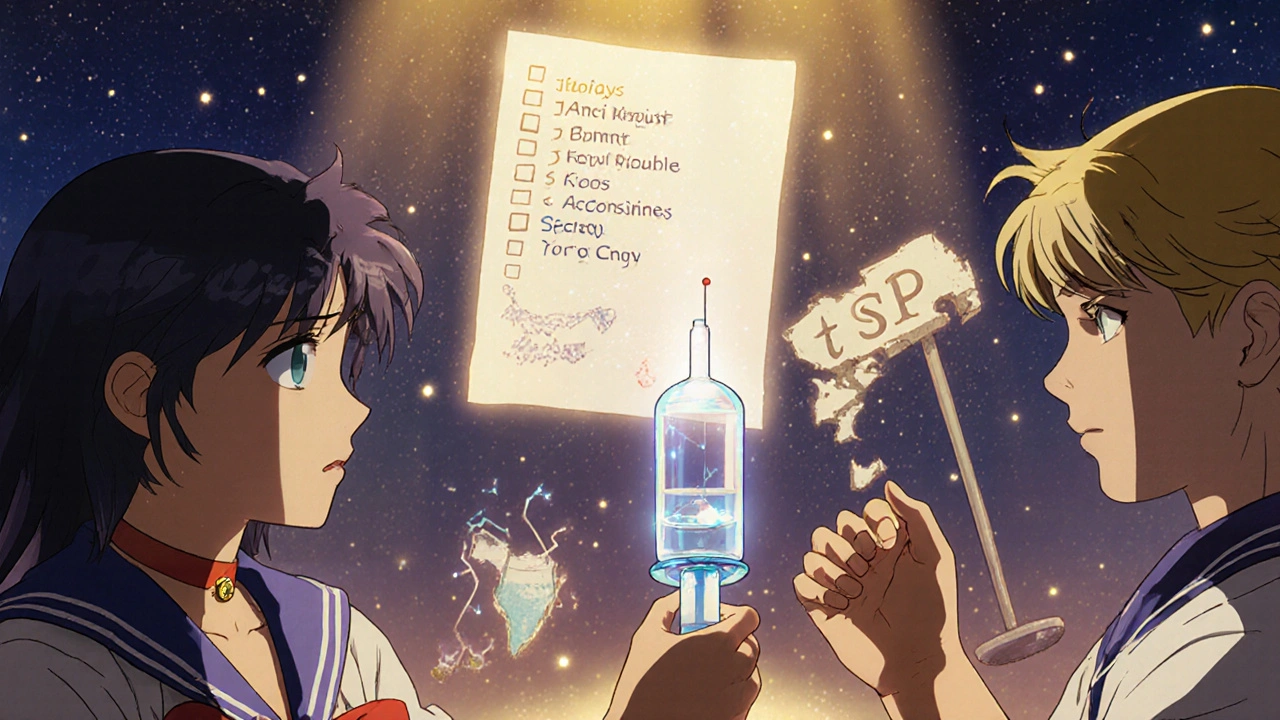How to Ensure Accurate Dosing Devices with Liquid Prescriptions
 Nov, 19 2025
Nov, 19 2025
When a child needs liquid medicine, getting the dose right isn’t just important-it’s life-or-death. A 2023 study found that 15% to 43% of caregivers make dangerous mistakes when measuring liquid prescriptions, often because they’re using the wrong tool or misreading the label. These aren’t small errors. A 20% overdose of antibiotics or pain relievers can send a child to the ER. The good news? Most of these errors are preventable. And the solution isn’t complicated: use the right device, read the label correctly, and make sure both match.
Why Household Spoons Are Dangerous
You’ve probably heard it before: "Use a teaspoon." But a kitchen teaspoon isn’t a medical tool. In fact, the volume of a household spoon varies wildly-from 3 mL to over 7 mL-depending on how full you scoop it, the shape of the spoon, or even how you hold it. The Institute for Safe Medication Practices says 40% of pediatric dosing errors happen because caregivers use spoons instead of calibrated devices. That’s not a myth. It’s data. The FDA banned the use of "teaspoon" and "tablespoon" on prescription labels in 2011, and reinforced that rule in 2022. But you’ll still see it on older bottles, especially over-the-counter medicines. If the label says "5 tsp," don’t trust it. Ask for a proper dosing device. Even if the label says "5 mL," don’t assume the spoon that came with the bottle is accurate.The Best Device for the Job: Oral Syringes
If you’re giving liquid medicine to a child under 10 years old-or any dose under 10 mL-oral syringes are the gold standard. They’re not perfect, but they’re the most accurate tool available. Studies show oral syringes have a mean error rate of just 0.5 mL when measuring a 5 mL dose. Compare that to dosing cups, which average 1.3 mL of error. That’s more than double the inaccuracy. For a 2.5 mL dose, only 4% of users made a mistake with a syringe. With a 15 mL cup? 43% got it wrong. Syringes also let you measure fractions of a milliliter. If the prescription says 1.6 mL, a syringe with 0.1 mL markings makes it easy. A cup with only 1 mL and 2 mL lines? You’re guessing. One parent on Amazon wrote: "The 1 mL syringe with 0.1 mL markings saved my infant from an overdose. The cup only had 1 mL and 2 mL lines."Why Dosing Cups Fail
Dosing cups are still the most common device handed out with prescriptions-58% of pediatric liquid meds come with them. But they’re flawed by design. First, there’s parallax error. If you don’t hold the cup at eye level, the liquid looks higher or lower than it really is. Most people don’t realize this. Second, cups often have too many markings. The JAMA Network study found that 81.1% of dosing cups include unnecessary lines-like 3 mL, 4 mL, 7 mL-when the prescription only calls for 5 mL. More lines mean more confusion. Cups also tend to be too big. If the largest dose is 5 mL, the cup shouldn’t hold more than 10-15 mL. But many hold 30 mL or more. That makes it harder to control the pour and easier to overfill. And don’t forget: the meniscus-the curve of the liquid surface-is hard to read on plastic cups, especially with dark liquids.
What the Label Should Say
The label and the device must match. That’s non-negotiable. The FDA, USP, and American Academy of Pediatrics all agree: only use milliliters (mL) on labels and devices. No "tsp," no "tbsp," no "cc." Just mL. And numbers should be written correctly: 0.5 mL, not .5 mL. No trailing zeros: 5 mL, not 5.0 mL. These seem like small details, but they matter. A 2014 JAMA Pediatrics study showed parents who used mL-only labels made 42% fewer errors. If the label says "give 2.5 mL," the syringe you get should have 0.1 mL markings and go up to at least 3 mL. If it doesn’t, ask the pharmacist for a better one. You have the right to ask for a device that matches the prescription.How to Use an Oral Syringe Correctly
Even the best tool fails if used wrong. Here’s how to do it right:- Draw air into the syringe equal to the dose (e.g., if you need 3 mL, pull back to 3 mL with air).
- Insert the tip into the bottle, then push the plunger to push air into the bottle. This prevents a vacuum.
- Turn the bottle upside down and slowly pull the plunger back until the liquid reaches your dose mark.
- Tap the side of the syringe gently to bring any air bubbles to the top, then push them out.
- Hold the syringe at eye level and read the mark where the top of the liquid meets the line-not the bottom.
What Pharmacists Should Be Doing
Pharmacists are the last line of defense. Too often, they hand out a cup with a 10 mL dose. That’s not good enough. The American Pharmacists Association recommends giving an oral syringe for all liquid prescriptions under 10 mL. A 2020 multicenter trial showed this cut dosing errors by 28%. But only 35% of pediatric prescriptions in the U.S. come with syringes. That’s a failure. Pharmacists should also check the label and the device. If the label says "5 mL" but the cup says "1 tsp," fix it. If the bottle has no device, provide one. Many pharmacies now use QR codes on labels that link to short videos showing how to use the syringe. CVS’s "DoseRight" and Walgreens’s "PrecisionDose" are examples of this working well.
What to Do If You’re Given the Wrong Device
You don’t have to accept what’s handed to you. If you get a dosing cup for a 2 mL dose, say: "Can I please get an oral syringe?" If they say no, ask why. If they still refuse, go to another pharmacy. It’s your child’s safety. You can also buy your own oral syringes online or at any pharmacy. They cost less than $2. Look for ones with 0.1 mL increments and a plunger that doesn’t stick. Avoid syringes with a wide tip-they’re harder to use with bottles.Why This Matters Beyond the Pharmacy
This isn’t just about pills and syringes. It’s about trust in the system. When caregivers make dosing errors, they feel guilty. They blame themselves. But the problem isn’t them-it’s poor design, inconsistent labeling, and outdated practices. Between 2015 and 2022, pediatric liquid medication errors dropped by 37% because of better standards. But we’re not done. 28% of liquid meds still use teaspoons on labels. 63% of low-income families get lower-quality devices. And only 12 states check pharmacy compliance. Better dosing isn’t just a medical issue. It’s a social justice issue. Everyone deserves a safe, accurate way to give medicine-no matter their income, education, or where they live.Final Checklist: Your Dosing Safety Plan
Before giving any liquid medicine, ask yourself:- Is the dose written in mL-not teaspoons or tablespoons?
- Do I have a dosing device that matches the dose? (e.g., 0.1 mL increments for doses under 5 mL)
- Is the device marked with the same units as the label?
- Am I using an oral syringe for doses under 10 mL?
- Did I read the liquid at eye level?
- Did I tap out air bubbles before giving it?
- Did I practice with water first?
Can I use a kitchen teaspoon if I don’t have a dosing device?
No. A kitchen teaspoon holds between 3 and 7 mL, and it’s not calibrated. Using it risks underdosing or overdosing your child. If you don’t have a proper device, call your pharmacy or visit one immediately. Oral syringes cost under $2 and are available without a prescription.
Why do pharmacies still give out dosing cups?
Many pharmacies still use dosing cups because they’re cheaper and caregivers often ask for them. Cups are easier to use at first glance, even though they’re less accurate. But this is changing. More pharmacies now provide syringes for pediatric doses, especially after FDA and USP guidelines were strengthened. If you’re given a cup, ask for a syringe instead.
Is it okay to use a dropper for liquid medicine?
Droppers are better than spoons but not as good as syringes. They’re okay for small doses under 2 mL, but they’re inconsistent for larger amounts. The error rate for droppers is around 22% for a 2.5 mL dose. For anything over 2 mL, use an oral syringe. Always check the markings-if the dropper says "mL," it’s better than one that says "drops."
What if the prescription says 0.8 mL? How do I measure that?
You need a syringe with 0.1 mL markings. A 1 mL syringe is perfect for this. Draw the liquid slowly until the top of the meniscus lines up with the 0.8 mL mark. Hold it at eye level. If the syringe you’re given doesn’t have 0.1 mL markings, ask for a different one. Never guess a fraction of a milliliter.
Are there apps or smart devices that help with dosing?
Yes. Walgreens’s PrecisionDose syringes connect to a smartphone app that verifies the dose before it’s given. Some smart bottles also track when doses are taken. But these are still rare and expensive. For now, the best tool is still a simple, well-marked oral syringe and a clear label. Don’t wait for tech-use what works now.

Jeremy Samuel
November 19, 2025 AT 11:13Destiny Annamaria
November 20, 2025 AT 22:08Ron and Gill Day
November 22, 2025 AT 02:04Alyssa Torres
November 22, 2025 AT 22:47Summer Joy
November 23, 2025 AT 02:04Aruna Urban Planner
November 24, 2025 AT 10:46Nicole Ziegler
November 24, 2025 AT 17:42Bharat Alasandi
November 25, 2025 AT 18:32Kristi Bennardo
November 26, 2025 AT 16:08Shiv Karan Singh
November 27, 2025 AT 09:27Ravi boy
November 29, 2025 AT 07:22Matthew Karrs
November 30, 2025 AT 03:49Matthew Peters
December 1, 2025 AT 01:33Liam Strachan
December 1, 2025 AT 18:59Gerald Cheruiyot
December 2, 2025 AT 03:16